PHLDA3
-
Official Full Name
pleckstrin homology-like domain, family A, member 3 -
Overview
Pleckstrin homology-like domain family A member 3 (PHLDA3) is one of three relatively small, similar proteins that share a common pleckstrin homology (PH) domain. Expression of PHLDA3 and the related PHLDA1 occurs in several fetal and adult tissues, in co -
Synonyms
PHLDA3;pleckstrin homology-like domain, family A, member 3;pleckstrin homology-like domain family A member 3;pleckstrin homology like domain;family A;member 2;TIH1;TDAG51/Ipl homolog 1;pleckstrin homology-like domain, family A, member 2
Recombinant Proteins
- Human
- Mouse
- Rat
- Zebrafish
- E.coli
- Mammalian Cells
- HEK293
- Wheat Germ
- In Vitro Cell Free System
- GST
- His
- Non
- DDK
- Myc
- Avi
- Fc
Background
What is PHLDA3 Protein?
PHLDA3 is a type of protein that's starting to get attention in cancer research. It's known as a tumor suppressor because it can slow down or halt the growth of cancer cells. What makes PHLDA3 interesting is its role in the PI3K-Akt pathway, a key player in cell survival and growth. By competing with other molecules in this pathway, PHLDA3 keeps the Akt protein from being activated. This can slow down cancer progression, making it a potential target for therapies, especially in cancers like prostate and neuroendocrine tumors. Researchers are diving deeper into how PHLDA3 works, hoping to unlock new treatment options for tough-to-treat cancers.What is the Function of PHLDA3 Protein?
PHLDA3 is like a traffic cop for cell growth, especially in controlling the PI3K-Akt pathway. This pathway often helps cancer cells thrive, so when PHLDA3 blocks Akt activation, it slows down the cancer cells. By limiting this growth pathway, PHLDA3 acts like a natural defense against tumors, potentially offering a new angle for cancer therapies. This is particularly important for aggressive cancers like prostate and pancreatic types, where researchers are looking into boosting PHLDA3 to stop tumor progression effectively.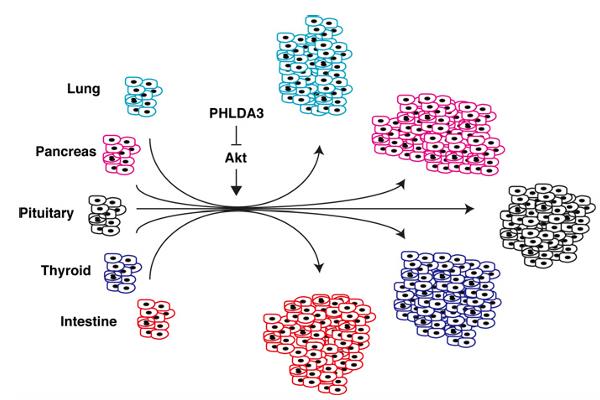
Fig1. PHLDA3 is a tumor suppressor gene of neuroendocrine tumors (NET). (Masahiro Takikawa, 2017)
PHLDA3 Related Signaling Pathway
PHLDA3 is important for keeping the PI3K-Akt signaling pathway in check, which is a crucial path that cells use to grow and survive. When this pathway goes into overdrive, it can lead to cancer. PHLDA3 jumps into action by getting in the way of molecules that activate Akt, a key protein in this process. It basically stops Akt from turning on, which helps slow down cell growth. This makes PHLDA3 a crucial player in preventing uncontrolled cell multiplication, especially in tough cancers like prostate and pancreatic. Figuring out how PHLDA3 works in this pathway could lead to new ways to treat cancer by targeting these specific processes.PHLDA3 Related Diseases
PHLDA3 is tied to various diseases, mostly different types of cancer. It's supposed to help control how cells grow by keeping a check on the PI3K-Akt pathway. But when PHLDA3 levels drop, this pathway can run wild, leading to tumors, particularly in cancers like prostate and pancreatic cancer. Scientists see PHLDA3 as a promising target for cancer therapy because it can keep cell growth under control. Its link to these cancers makes it an important focus for developing new treatments to tackle these aggressive diseases.Bioapplications of PHLDA3
PHLDA3 is gaining attention in biotechnology, especially for cancer research and therapies. It plays a big role in keeping cell growth in check by targeting the PI3K-Akt pathway. This makes it a potential game-changer for developing new cancer treatments, as scientists aim to use PHLDA3 to stop tumors from growing, particularly in tough cancers like prostate and pancreatic cancer. PHLDA3’s role in controlling cell signaling opens up possibilities for tackling other diseases with abnormal cell growth, making it a key focus for future medical breakthroughs.Case Study
Case Study 1: Ma S. et al. Biochem Biophys Res Commun. 2021
PHLDA3 is a protein linked to cancer, but its role in prostate cancer isn't well-understood. This research found that PHLDA3 levels are low in prostate cancer and associated with poor patient survival. Increasing PHLDA3 can slow cancer cell growth, arrest the cell cycle, and enhance sensitivity to docetaxel, a chemotherapy drug. It works by inhibiting the Akt pathway and Wnt/β-catenin signaling, reducing tumor growth in tests. These results suggest PHLDA3 could be a potential target for prostate cancer treatment.-
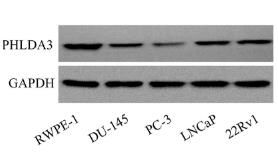 Fig1. Expression levels of PHLDA3 in prostate cancer cell lines were examined via western blot.
Fig1. Expression levels of PHLDA3 in prostate cancer cell lines were examined via western blot. -
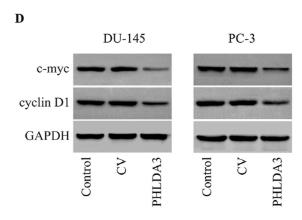 Fig2. The effects of PHLDA3 overexpression on the levels of c-myc and cyclin D1 were assessed via western blotting.
Fig2. The effects of PHLDA3 overexpression on the levels of c-myc and cyclin D1 were assessed via western blotting.
Case Study 2: Takikawa M. et al. Cancer Sci. 2017
Pancreatic neuroendocrine tumors (PanNET) are rare and tough to treat. Understanding their development is key for better diagnosis and treatment. The mTOR inhibitor everolimus can help patients by blocking the PI3K-Akt-mTOR pathway, which plays a role in PanNET progression. Here the tumor suppressor PHLDA3, which inhibits Akt, is often suppressed in PanNET due to genetic changes. Similar issues with PHLDA3 are seen in lung neuroendocrine tumors, indicating a common trend across different NET types.-
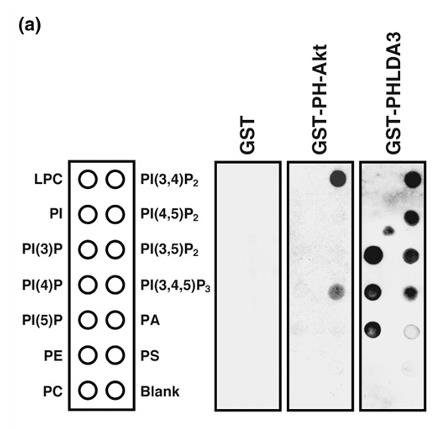 Fig3. Binding of GST-PHLDA3, GST-PH-Akt or GST to immobilized PIP was assessed by protein-lipid overlay assay.
Fig3. Binding of GST-PHLDA3, GST-PH-Akt or GST to immobilized PIP was assessed by protein-lipid overlay assay. -
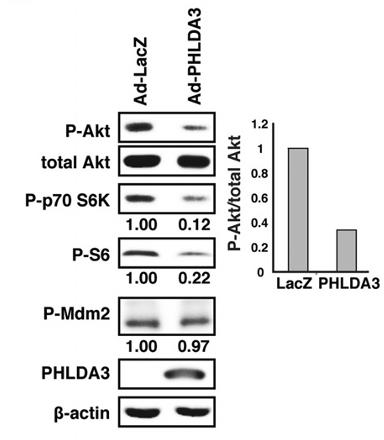 Fig4. Effect of PHLDA3 expression on Akt activity in MIN6 cells.
Fig4. Effect of PHLDA3 expression on Akt activity in MIN6 cells.
Quality Guarantee
High Purity
-
.jpg) Fig1. SDS-PAGE (PHLDA3-1690H)
Fig1. SDS-PAGE (PHLDA3-1690H) -
.jpg) Fig2. SDS-PAGE (PHLDA3-1691H)
Fig2. SDS-PAGE (PHLDA3-1691H)
Involved Pathway
PHLDA3 involved in several pathways and played different roles in them. We selected most pathways PHLDA3 participated on our site, such as , which may be useful for your reference. Also, other proteins which involved in the same pathway with PHLDA3 were listed below. Creative BioMart supplied nearly all the proteins listed, you can search them on our site.
| Pathway Name | Pathway Related Protein |
|---|
-
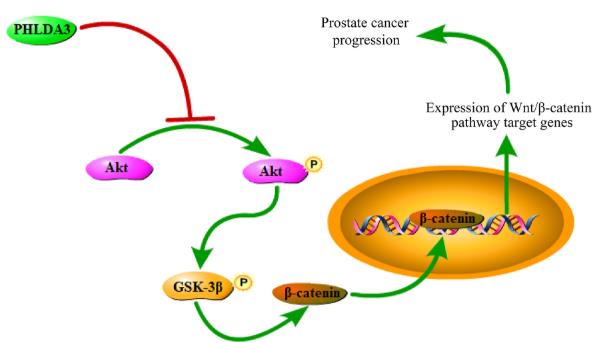 Fig1. A proposed graphical model for the PHLDA3-mediated Akt/Wnt/β-catenin pathway in prostate cancer progression. (Shuaijun Ma, 2021)
Fig1. A proposed graphical model for the PHLDA3-mediated Akt/Wnt/β-catenin pathway in prostate cancer progression. (Shuaijun Ma, 2021) -
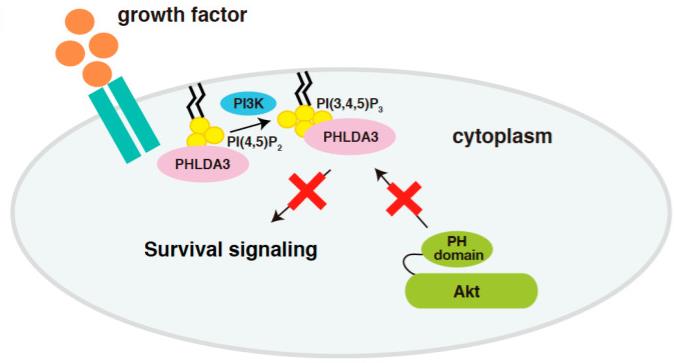 Fig2. A model of Akt repression by PHLDA3. (Yu Chen, 2020)
Fig2. A model of Akt repression by PHLDA3. (Yu Chen, 2020)
Protein Function
PHLDA3 has several biochemical functions, for example, phosphatidylinositol-3,4,5-trisphosphate binding,phosphatidylinositol-3,4-bisphosphate binding,phosphatidylinositol-3,5-bisphosphate binding. Some of the functions are cooperated with other proteins, some of the functions could acted by PHLDA3 itself. We selected most functions PHLDA3 had, and list some proteins which have the same functions with PHLDA3. You can find most of the proteins on our site.
| Function | Related Protein |
|---|---|
| phosphatidylinositol-3,4,5-trisphosphate binding | D6WSU116E,KIF16B,GAB2,ARAP2,PIRT,ARHGAP9,ZFYVE1,JPH2,AKT1,ARAP1 |
| phosphatidylinositol-4,5-bisphosphate binding | TWF1,Apba1,KCNJ1,FAM21C,TIRAP,CHMP3,EXOC1,FCHO2,ADAP2,KRIT1 |
| phosphatidylinositol-3,4-bisphosphate binding | MYO1G,COMMD1,ZFYVE1,GAB2,SESTD1,MAPKAP1,RS1,AKT1,ADAP2,ANXA8 |
| phosphatidylinositol-5-phosphate binding | SH3PXD2B,PLEKHF1,SESTD1,RS1,SNX3,FAM21C,LANCL2,JPH2,SNX24,D6WSU116E |
| phosphatidylinositol-3,5-bisphosphate binding | GBF1,FAM21C,SNX14,SNX3,SH3PXD2B,WDR45,MAPKAP1,WDR45B,CLVS2,COMMD1 |
| phosphatidylinositol-3-phosphate binding | NCF4,WDR45,BBS5,KIF16B,WIPI1,ZFYVE19,LANCL2,WIPI2,WDR45B,D6WSU116E |
Interacting Protein
PHLDA3 has direct interactions with proteins and molecules. Those interactions were detected by several methods such as yeast two hybrid, co-IP, pull-down and so on. We selected proteins and molecules interacted with PHLDA3 here. Most of them are supplied by our site. Hope this information will be useful for your research of PHLDA3.
MYO1C;RFXANK;POLR1C;ZW10;IDH3B;DPM1;DNAJB6;SLC25A12;TRIO;ATP5L;MYO1D;UFL1;PRPF6;AHSA1;NTRK1;RPN2
Resources
Related Services
Related Products
References
- Honarpisheh, H; Glusac, EJ; et al. Cytokeratin 20 expression in basaloid follicular hamartoma and infundibulocystic basal cell carcinoma. JOURNAL OF CUTANEOUS PATHOLOGY 41:916-921(2014).


